Xylophanes kiefferi
Updated as per CATE Sphingidae: Panama, Colombia, Ecuador
Updated as per personal communication with Pia Oberg (Ecuador: Napo: Wildsumaco, March 1, 2011); November 30, 2011
Updated as per personal communication with Vadim Kroutov (wingspans, verso images, Esmeraldas, Ecuador); February 21, 2015
|
Xylophanes kiefferi
zail-AH-fan-eesMkee-FER-eye
or
zye-LAH-fan-eesMkee-FER-eye
Cadiou, 1995
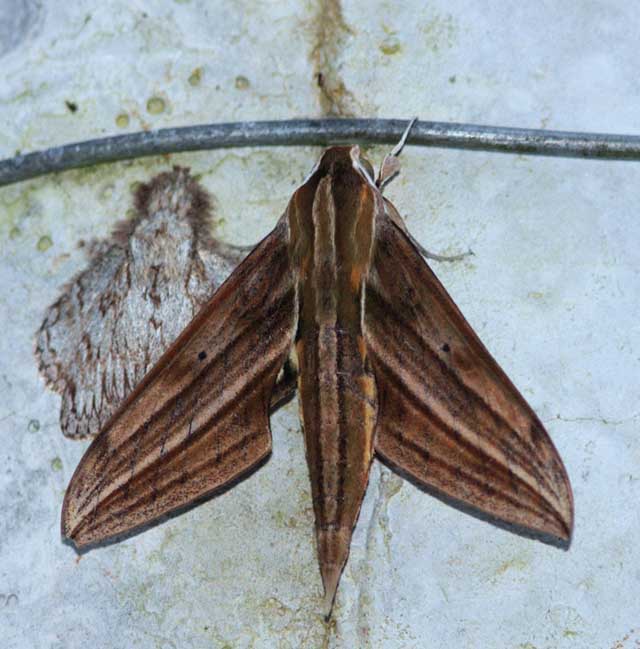
Xylophanes kiefferi, Wildsumaco Lodge, Napo, Ecuador,
1400m, March 1, 2011, courtesy of Pia Oberg, id by Bill Oehlke.
This site has been created by
Bill Oehlke at oehlkew@islandtelecom.com
Comments, suggestions and/or additional information are welcomed by Bill.
TAXONOMY:
Family: Sphingidae, Latreille, 1802
Subfamily: Macroglossinae, Harris, 1839
Tribe: Macroglossini, Harris, 1839
Genus: Xylophanes Hubner [1819] ...........
Species: kiefferi Cadiou, 1995
|
MIDI MUSIC
.....It's a Wonderful World.....
copyright C. Odenkirk
ON.OFF
<bgsound src="world.mid" LOOP=FOREVER>
|
DISTRIBUTION:
Xylophanes kiefferi (wingspan: males: 77-82mm; females: 92-94mm)
flies in
Colombia (specimen type locality);
Panama; and
Ecuador: Esmeraldas (VK), Pichincha, Napo: Wildsumaco Lodge (PO).
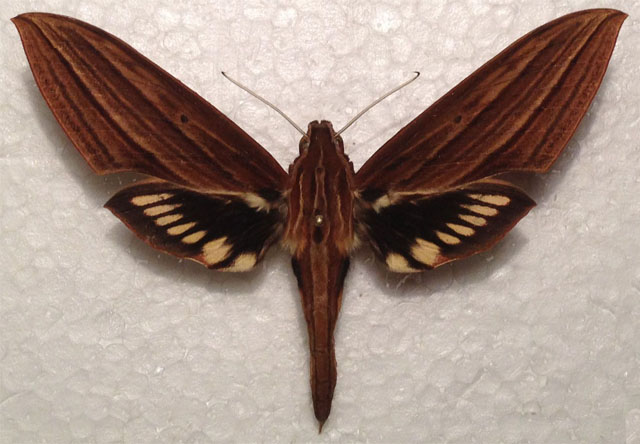
Xylophanes kiefferi female, 92mm, Esmeraldas, Ecuador,
courtesy of Vadim Kroutov.
"Similar to Xylophanes aristor but more robust and outer edge of forewing straighter.
"Upperside of body deep rich brown (olive-green in Xylophanes aristor).
Forewing upperside similar to Xylophanes aristor but ground colour a deep rich brown (rather than olive-green) and first and fourth postmedian lines farther apart.
"Forewing underside similar to Xylophanes aristor but brown; basal area dark brown grey and less extensive, so that first postmedian line remains visible to the
inner margin; second postmedian line heavier, sinuate and continuous, reaching the inner margin; dark marginal area closer to postmedian area, reaching the third one
(represented by vein dots), delineated by a grey line that is toothed between M2 and M3 (as in Xylophanes vagliai) apical area, between costa and Rs4 beyond most
distal costal dark spot, shorter, brighter yellow.
"Anal area of hindwing underside bright yellow (whitish in Xylophanes aristor)." CATE
A view of the underside of the forewings greatly helps distinguish kiefferi from other very similar species which often have the entire basal area dark grey to black.
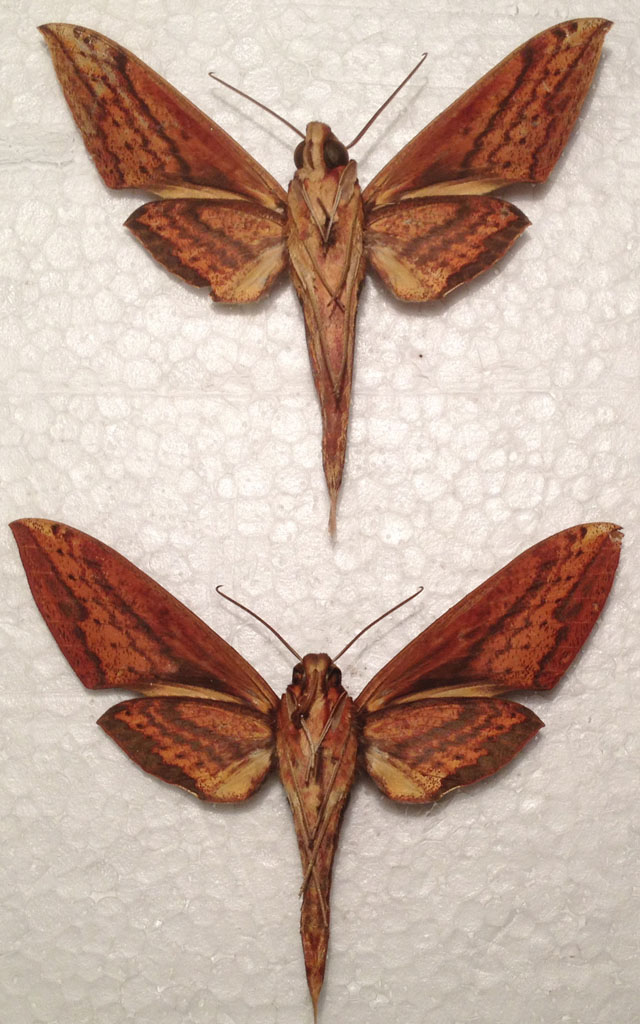
Xylophanes kiefferi male, 77mm; female, 92mm;
verso, Esmeraldas, Ecuador, courtesy of Vadim Kroutov.
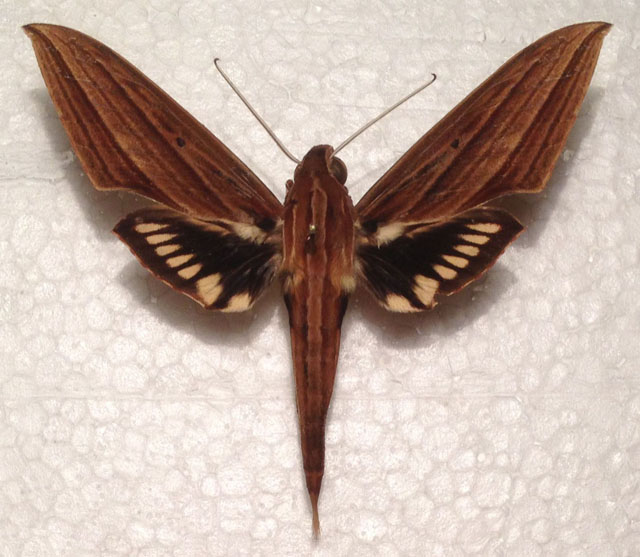
Xylophanes kiefferi male, 77mm, Esmeraldas, Ecuador,
courtesy of Vadim Kroutov.
FLIGHT TIMES:
Xylophanes kiefferi adults probably
fly as multiple broods.
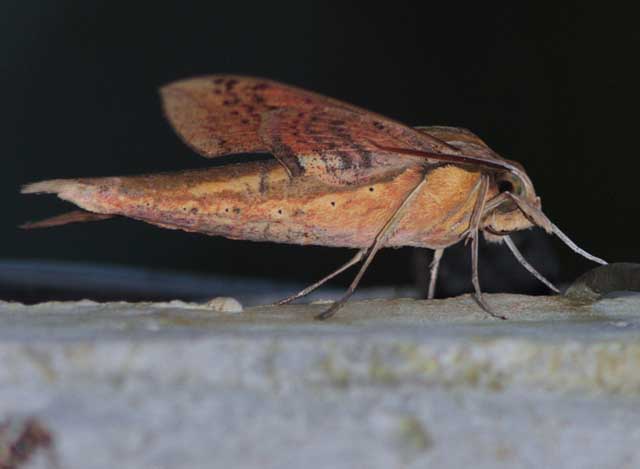
Xylophanes kiefferi (verso), Wildsumaco Lodge, Napo, Ecuador,
1400m, March 1, 2011, courtesy of Pia Oberg, id by Bill Oehlke.
ECLOSION:
Pupae probably wiggle to surface from subterranean chambers just prior to eclosion.
SCENTING AND MATING:Females call in the males with a pheromone released from a gland at the tip of the
abdomen. Males come in to lights very readily, but females are seldom taken in that way (maybe not).
EGGS, LARVAE, PUPAE:
Larvae probably feed on
plants of the Rubiaceae family and of
the Malvaceae family.
Moths emerge approximately one-two months after larvae pupate.
Use your browser "Back" button to return to the previous page.
Goto Main Sphingidae Index
Goto Macroglossini Tribe
Goto Central American Indices
Goto Carribean Islands
Goto South American Indices
Goto U.S.A. tables
The pronunciation of scientific names is
troublesome for many. The "suggestions" at the top of the page are
merely suggestions. They are based on commonly
accepted English pronunciation of Greek names and/or some
fairly well accepted "rules" for latinized scientific names.
In some cases I have anglicized the pronunciations as per
more common usage.
The suggested pronunciations, on this page and on other pages,
are primarily put forward to assist those who hear with internal
ears as they read.
There are many collectors from different countries whose
intonations and accents would be different.
Jean Marie Cadiou writes, "When I say "Xylophanes" in English I
pronounce it something like "Zailophanees", with the emphasis on the
"o". The French pronounce it differently, something like
"Kzeelophaness" with no emphasis, and the Germans yet in a
different way..."
In Greek myth, Phanes is the golden winged Primordial Being who
was hatched from the shining Cosmic Egg that was the source of the
universe. He personifies light emerging from chaos.
"Xylo" is the Greek word for wood.
The specimen type for the genus
Xylophanes is Xylophanes anubus. Perhaps ? when Hubner
examined this species, the yellow-orange and brown tones of the
forewings suggested wings of wood.
Jean Marie Cadiou writes, X. kiefferi is named after my good
friend Pierre Kieffer, from Metz, France. He is a butterfly
enthusiast, and gave me the first known specimen of this species.
Suggested pronunciation is 'kee-fer-ai', unless you prefer to
describe it as 'kee-fur-ai'."
Jean Marie's "ai" and my "eye" are pronounced the same.




